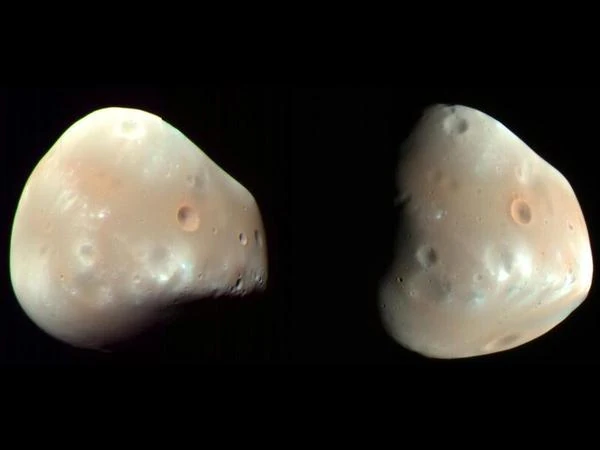
Deimos, the smaller and outermost of Mars' two moons, remains one of the least understood celestial bodies in the inner solar system. Discovered on August 11, 1877 by Asaph Hall, it orbits Mars at a distance of about 23,460 km with an orbital period of 30.3 hours. Its origin, long debated, may be linked to the capture of a main-belt asteroid or a giant impact on Mars, similar to the leading hypothesis for the formation of our Moon.
N.B. :
Asaph Hall named Mars' moons after the mythological sons of Ares (god of war), the Greek counterpart of the Roman god Mars. Deimos, whose name means "fear," is the twin of Phobos, meaning "terror."
With an average diameter of just 12.4 km, Deimos is an irregular body shaped like a triaxial ellipsoid (15 × 12.2 × 10.4 km). Its mass is estimated at 1.48 × 1015 kg, and its average density of 1.47 g/cm3 suggests a composition similar to D-type carbonaceous asteroids, rich in organic materials and hydrated silicates. Unlike Phobos, its surface lacks mysterious grooves but is marked by impact craters, the largest of which, Swift, measures about 3 km in diameter.
When Deimos is struck by a celestial object, dust and debris escape its surface due to weak gravitational pull. However, Mars' gravity retains these debris in a ring around the planet, roughly in the same region as Deimos' orbit. As the moon rotates, the debris resettles as a dusty layer, giving it a smooth appearance.
N.B.:
Deimos' low density and albedo (light reflection) of 0.07 indicate a surface covered in dark regolith, similar to primitive asteroids. This supports the gravitational capture hypothesis, though recent models also suggest in situ formation from debris of a Martian impact.
Spectroscopic observations reveal similarities between Deimos and Martian Trojan asteroids and trans-Neptunian objects. Its surface primarily consists of:
The lack of internal differentiation (no distinct metallic core) suggests Deimos never underwent sufficient heating to melt, unlike planets or large moons.
Three main hypotheses explain Deimos' origin:
Future missions, such as JAXA's MMX (Martian Moons eXploration), could resolve this by returning samples from Phobos (and indirectly shedding light on Deimos' origin).
Though less studied than Phobos, Deimos has been observed by several missions:
Its stable orbit and lack of significant tidal forces make it a potential site for a Martian observation base or a communication relay for future crewed missions.
| Characteristic | Deimos | Phobos | Moon (Earth) |
|---|---|---|---|
| Average diameter (km) | 12.4 | 22.2 | 3,474 |
| Density (g/cm3) | 1.47 | 1.87 | 3.34 |
| Orbital period | 30.3 hours | 7.66 hours | 27.3 days |
| Distance from planet (km) | 23,460 | 9,376 | 384,400 |
| Likely origin | Capture or impact | Impact or capture | Giant impact |
Sources: NASA - Deimos Overview, ESA - Mars Express.